Study on the Shear Modulus Based Equivalent Homogenization Methods of Multi-Layer BCC Lattice Sandwich
Abstract
:1. Introduction
2. Shear Modulus Theory Model of Multi-Layer BCC Lattice Structures
2.1. Coordinate Transformation Method
2.2. Equivalent Shear Modulus of Typical Element under Constrained Boundary
2.3. Equivalent Shear Modulus of Typical Element under Unconstrained Boundary
2.4. BCC Lattice Shear Modulus Assembly under Two Deformations
2.4.1. H = B
2.4.2. H < B
2.4.3. H > B
3. Experimental and Numerical Simulation Validations
4. Conclusions
- (1)
- The deformation mode of a multi-layer BCC lattice sandwich structure under shear loading is indicated by two typical deformation modes at the macroscopic scale partitioned under a diagonal shear plane. One is the constrained boundary, and the other is unconstrained boundary. Different shear boundary conditions lead to different shear deformation behaviors.
- (2)
- The macro equivalent shear modulus theoretical model of multi-layer BCC lattice structures presented in this paper is in good agreement with the experimental and numerical simulation results, and can well reflect the macro shear mechanical properties.
- (3)
- The deformation features of different BCC lattice member exhibit different degrees of bending under shear loadings. When the slenderness ratio (r/l)of the member increases gradually, the deformation of the member changes from the bending deformation mode based on the assumption of Euler–Bernoulli beam to the shear deformation mode based on the assumption of Timoshenko beam. When the slenderness ratio (r/l) increases, the shear modulus of both cases (H = B, H < B, H > B) increases, but the shear modulus of H < B increases faster. In general, the theoretical equivalent shear modulus using Timoshenko beam theory is recommended for multilayer BCC lattices in the whole range of the slenderness ratio (r/l) for convenience in engineering applications.
Author Contributions
Funding
Institutional Review Board Statement
Informed Consent Statement
Data Availability Statement
Conflicts of Interest
References
- Monkova, K.; Vasina, M.; Zaludek, M.; Monka, P.; Tkac, J. Mechanical Vibration Damping and Compression Properties of a Lattice Structure. Materials 2021, 14, 1502. [Google Scholar] [CrossRef] [PubMed]
- Gu, D.; Shi, X.; Poprawe, R.; Bourell, D.L.; Setchi, R.; Zhu, J. Material-structure-performance integrated laser-metal additive manufacturing. Science 2021, 372, 372. [Google Scholar] [CrossRef] [PubMed]
- Blakey-Milner, B.; Gradl, P.; Snedden, G.; Brooks, M.; Pitot, J.; Lopez, E.; Leary, M.; Berto, F.; du Plessis, A. Metal additive manufacturing in aerospace: A review. Mater. Des. 2021, 209, 110008. [Google Scholar] [CrossRef]
- Pan, C.; Han, Y.; Lu, J. Design and Optimization of Lattice Structures: A Review. Appl. Sci. 2020, 10, 6374. [Google Scholar] [CrossRef]
- Xiong, J.; Ma, L.; Pan, S.; Wu, L.; Papadopoulos, J.; Vaziri, A. Shear and bending performance of carbon fiber composite sandwich panels with pyramidal truss cores. Acta Mater. 2012, 60, 1455–1466. [Google Scholar] [CrossRef]
- Dong, L.; Wadley, H. Shear response of carbon fiber composite octet-truss lattice structures. Compos. Part A Appl. Sci. Manuf. 2016, 81, 182–192. [Google Scholar] [CrossRef] [Green Version]
- Du, Y.; Li, H.; Luo, Z.; Tian, Q. Topological design optimization of lattice structures to maximize shear stiffness. Adv. Eng. Softw. 2017, 112, 211–221. [Google Scholar] [CrossRef]
- Feng, L.-J.; Xiong, J.; Yang, L.-H.; Yu, G.-C.; Yang, W.; Wu, L.-Z. Shear and bending performance of new type enhanced lattice truss structures. Int. J. Mech. Sci. 2017, 134, 589–598. [Google Scholar] [CrossRef]
- Zhang, Q.; Jiang, W.; Zhang, Y.; Tu, S.-T. Compression, Shear and Bending Performance of X-type Lattice Truss Panel Structure by Theoretical Method and Simulation. Int. J. Steel Struct. 2020, 20, 259–271. [Google Scholar] [CrossRef]
- Liu, W.; Li, H.; Zhang, J.; Gong, X.; Wang, Y.; Ge, X. Tensile and shear properties of star-shaped cellular lattice structure. Mech. Adv. Mater. Struct. 2020, 28, 2605–2617. [Google Scholar] [CrossRef]
- Popov, V.; Grilli, M.; Koptyug, A.; Jaworska, L.; Katz-Demyanetz, A.; Klobčar, D.; Balos, S.; Postolnyi, B.O.; Goel, S. Powder Bed Fusion Additive Manufacturing Using Critical Raw Materials: A Review. Materials 2021, 14, 909. [Google Scholar] [CrossRef] [PubMed]
- Wu, Q.; Vaziri, A.; Asl, M.E.; Ghosh, R.; Gao, Y.; Wei, X.; Ma, L.; Xiong, J.; Wu, L. Lattice materials with pyramidal hierarchy: Systematic analysis and three dimensional failure mechanism maps. J. Mech. Phys. Solids 2018, 125, 112–144. [Google Scholar] [CrossRef]
- Tancogne-Dejean, T.; Diamantopoulou, M.; Gorji, M.B.; Bonatti, C.; Mohr, D. 3D Plate-Lattices: An Emerging Class of Low-Density Metamaterial Exhibiting Optimal Isotropic Stiffness. Adv. Mater. 2018, 30, e1803334. [Google Scholar] [CrossRef] [PubMed]
- Echeta, I.; Dutton, B.; Leach, R.K.; Piano, S. Finite element modelling of defects in additively manufactured strut-based lattice structures. Addit. Manuf. 2021, 47, 102301. [Google Scholar] [CrossRef]
- Tsopanos, S.; Mines, R.A.W.; McKown, S.; Shen, Y.; Cantwell, W.; Brooks, W.; Sutcliffe, C.J. The Influence of Processing Parameters on the Mechanical Properties of Selectively Laser Melted Stainless Steel Microlattice Structures. J. Manuf. Sci. Eng. 2010, 132, 1–12. [Google Scholar] [CrossRef]
- Gümrük, R.; Mines, R.A.W.; Karadeniz, S. Static mechanical behaviours of stainless steel micro-lattice structures under different loading conditions. Mater. Sci. Eng. A 2013, 586, 392–406. [Google Scholar] [CrossRef]
- Leary, M.; Mazur, M.; Elambasseril, J.; McMillan, M.; Chirent, T.; Sun, Y.; Qian, M.; Easton, M.; Brandt, M. Selective laser melting (SLM) of AlSi12Mg lattice structures. Mater. Des. 2016, 98, 344–357. [Google Scholar] [CrossRef]
- Leary, M.; Mazur, M.; Williams, H.; Yang, E.; Alghamdi, A.; Lozanovski, B.; Zhang, X.; Shidid, D.; Farahbod-Sternahl, L.; Witt, G.; et al. Inconel 625 lattice structures manufactured by selective laser melting (SLM): Mechanical properties, deformation and failure modes. Mater. Des. 2018, 157, 179–199. [Google Scholar] [CrossRef]
- Li, C.; Lei, H.; Liu, Y.; Zhang, X.; Xiong, J.; Zhou, H.; Fang, D. Crushing behavior of multi-layer metal lattice panel fabricated by selective laser melting. Int. J. Mech. Sci. 2018, 145, 389–399. [Google Scholar] [CrossRef]
- Lee, K.-W.; Lee, S.-H.; Noh, K.-H.; Park, J.-Y.; Cho, Y.-J.; Kim, S. Theoretical and numerical analysis of the mechanical responses of BCC and FCC lattice structures. J. Mech. Sci. Technol. 2019, 33, 2259–2266. [Google Scholar] [CrossRef]
- Lei, H.; Li, C.; Meng, J.; Zhou, H.; Liu, Y.; Zhang, X.; Wang, P.; Fang, D. Evaluation of compressive properties of SLM-fabricated multi-layer lattice structures by experimental test and μ-CT-based finite element analysis. Mater. Des. 2019, 169, 107685. [Google Scholar] [CrossRef]
- Dos Reis, F.; Ganghoffer, J. Equivalent mechanical properties of auxetic lattices from discrete homogenization. Comput. Mater. Sci. 2012, 51, 314–321. [Google Scholar] [CrossRef]
- Somireddy, M.; Czekanski, A.; Singh, C.V. Development of constitutive material model of 3D printed structure via FDM. Mater. Today Commun. 2018, 15, 143–152. [Google Scholar] [CrossRef]
- Alaimo, A.; Marino, F.; Valvano, S. BCC lattice cell structural characterization. Rep. Mech. Eng. 2021, 2, 77–85. [Google Scholar] [CrossRef]
- Ptochos, E.; Labeas, G. Elastic modulus and Poisson’s ratio determination of micro-lattice cellular structures by analytical, numerical and homogenisation methods. J. Sandw. Struct. Mater. 2012, 14, 597–626. [Google Scholar] [CrossRef]
- Ptochos, E.; Labeas, G. Shear Modulus Determination of Cuboid Metallic Open-Lattice Cellular Structures by Analytical, Numerical and Homogenisation Methods. Strain 2012, 48, 415–429. [Google Scholar] [CrossRef]
- Liu, Y.; Dong, Z.; Ge, J.; Lin, X.; Liang, J. Stiffness design of a multilayer arbitrary BCC lattice structure with face sheets. Compos. Struct. 2019, 230, 111485. [Google Scholar] [CrossRef]
- Yang, Y.; Shan, M.; Zhao, L.; Qi, D.; Zhang, J. Multiple strut-deformation patterns based analytical elastic modulus of sandwich BCC lattices. Mater. Des. 2019, 181, 107916. [Google Scholar] [CrossRef]
- Ushijima, K.; Cantwell, W.; Mines, R.; Tsopanos, S.; Smith, M. An investigation into the compressive properties of stainless steel micro-lattice structures. J. Sandw. Struct. Mater. 2010, 13, 303–329. [Google Scholar] [CrossRef]
- Kohsaka, K.; Ushijima, K.; Cantwell, W.J. Study on vibration characteristics of sandwich beam with BCC lattice core. Mater. Sci. Eng. B 2021, 264, 114986. [Google Scholar] [CrossRef]

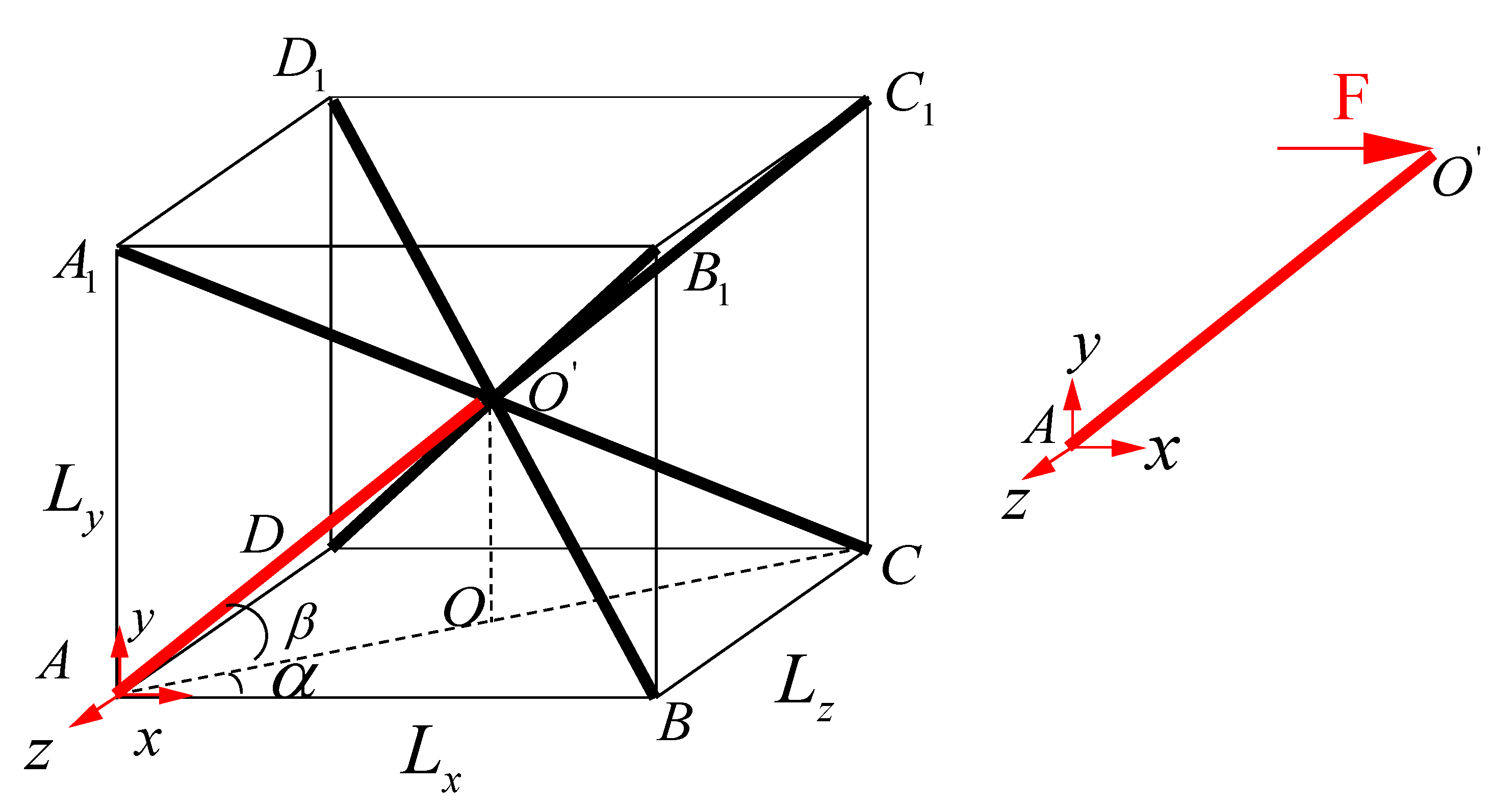
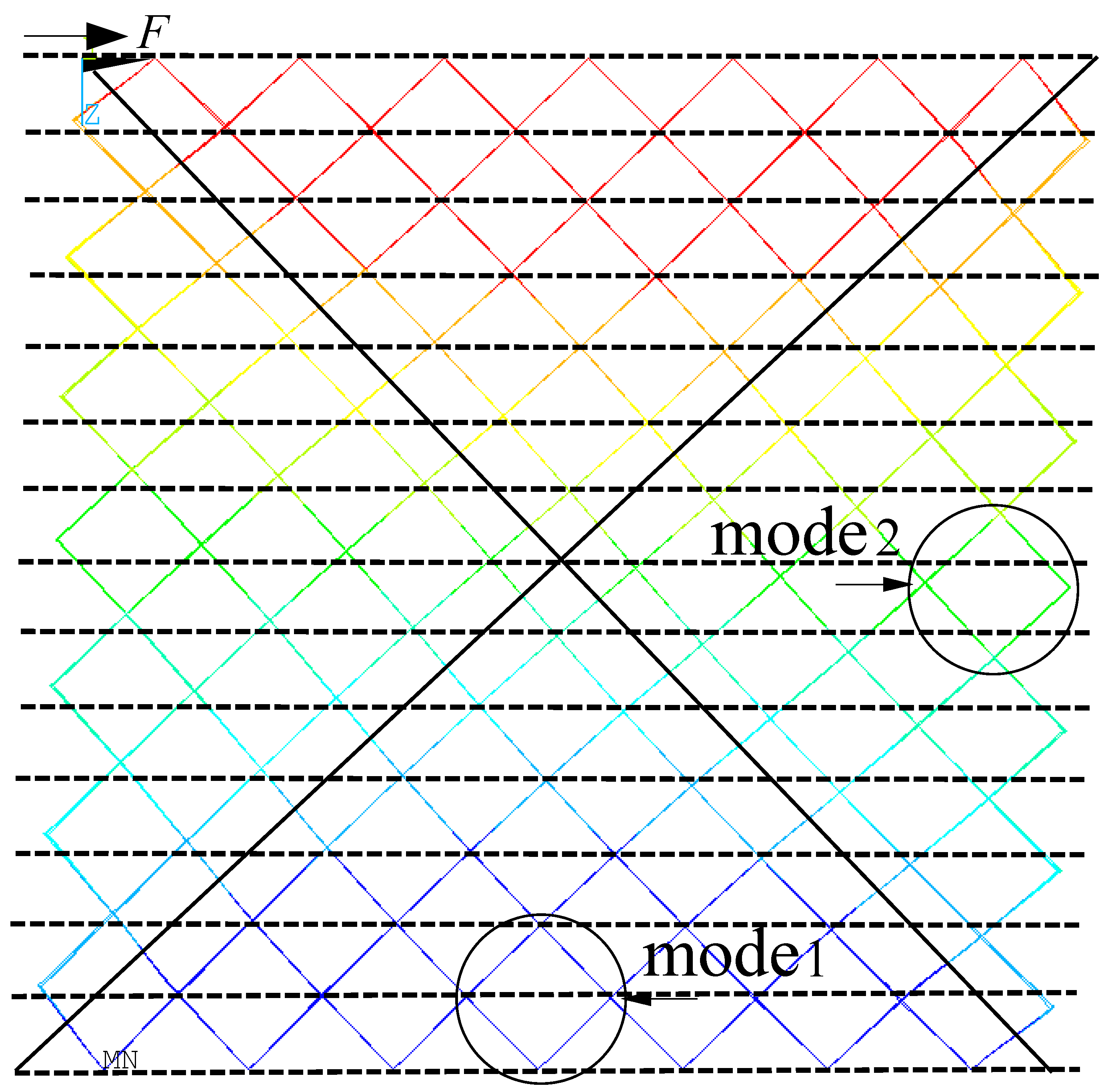

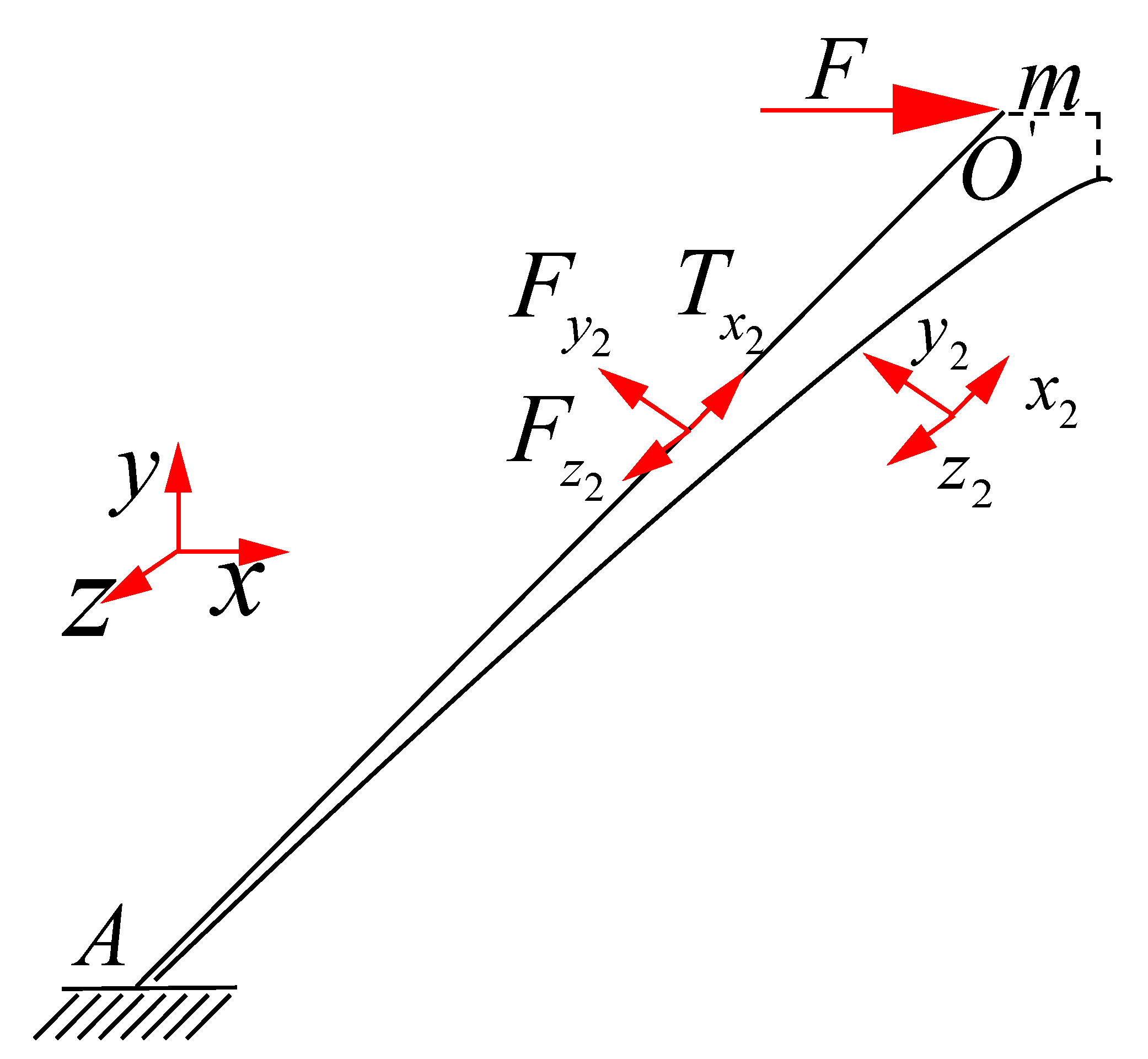
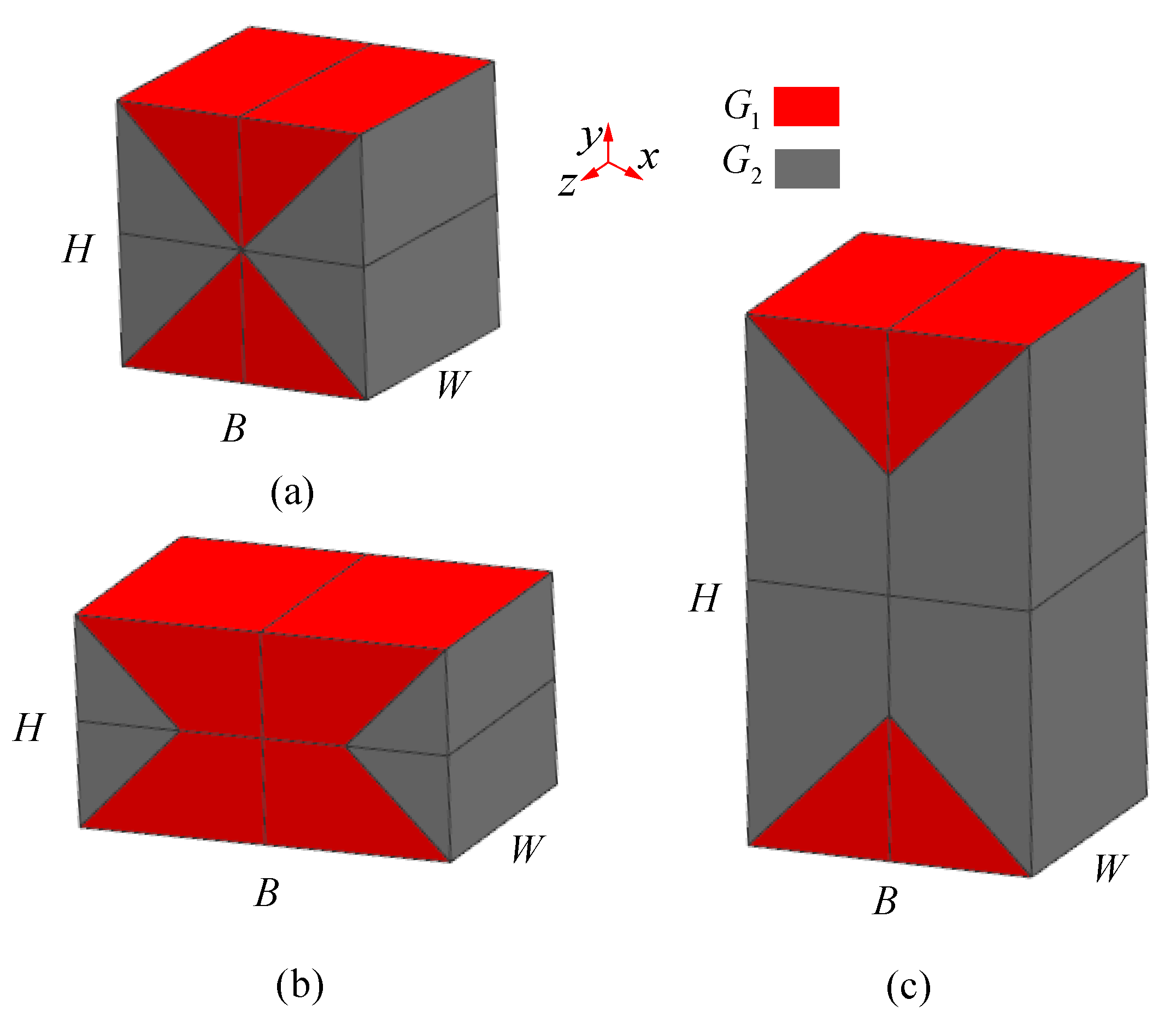



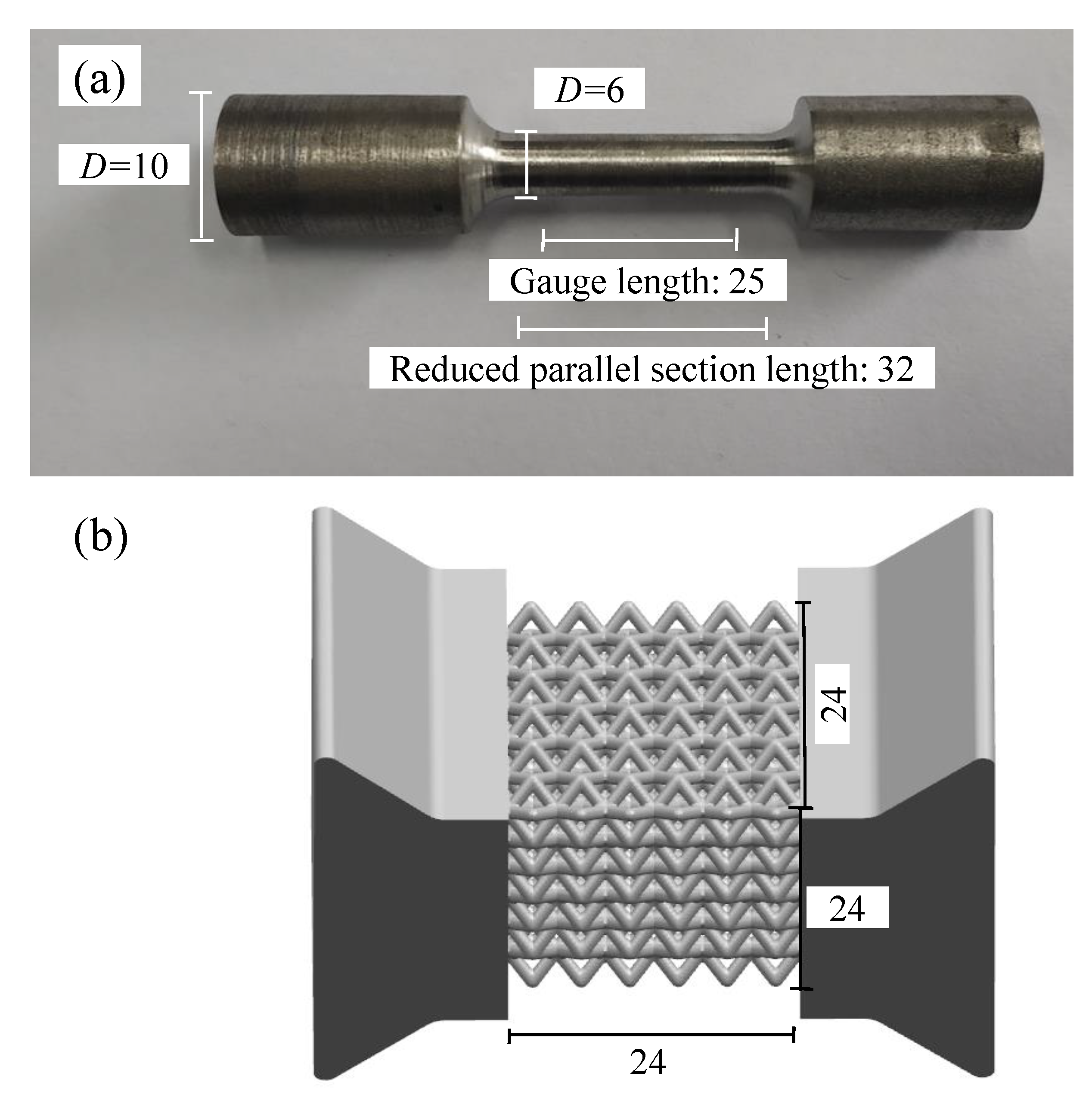



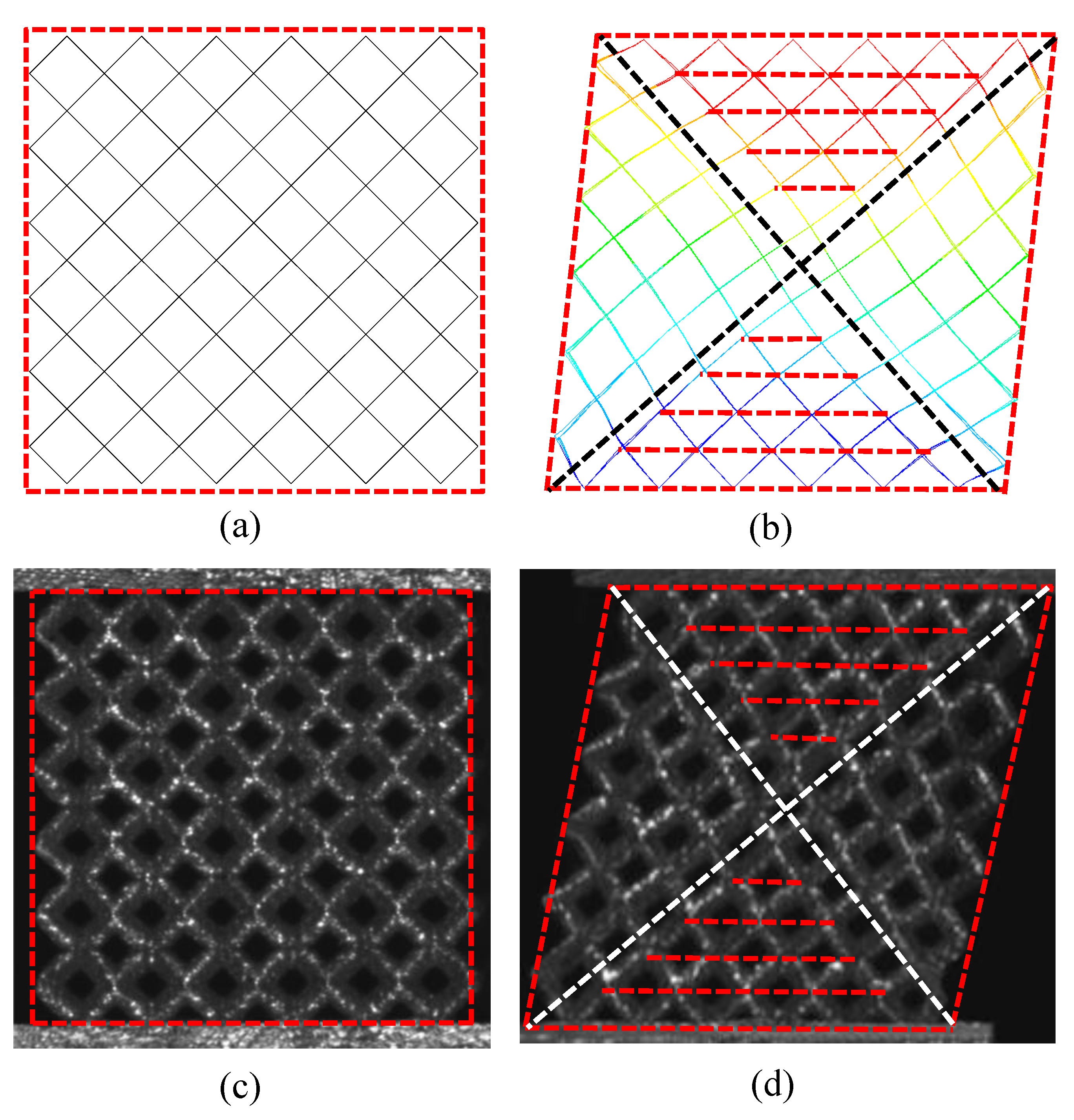

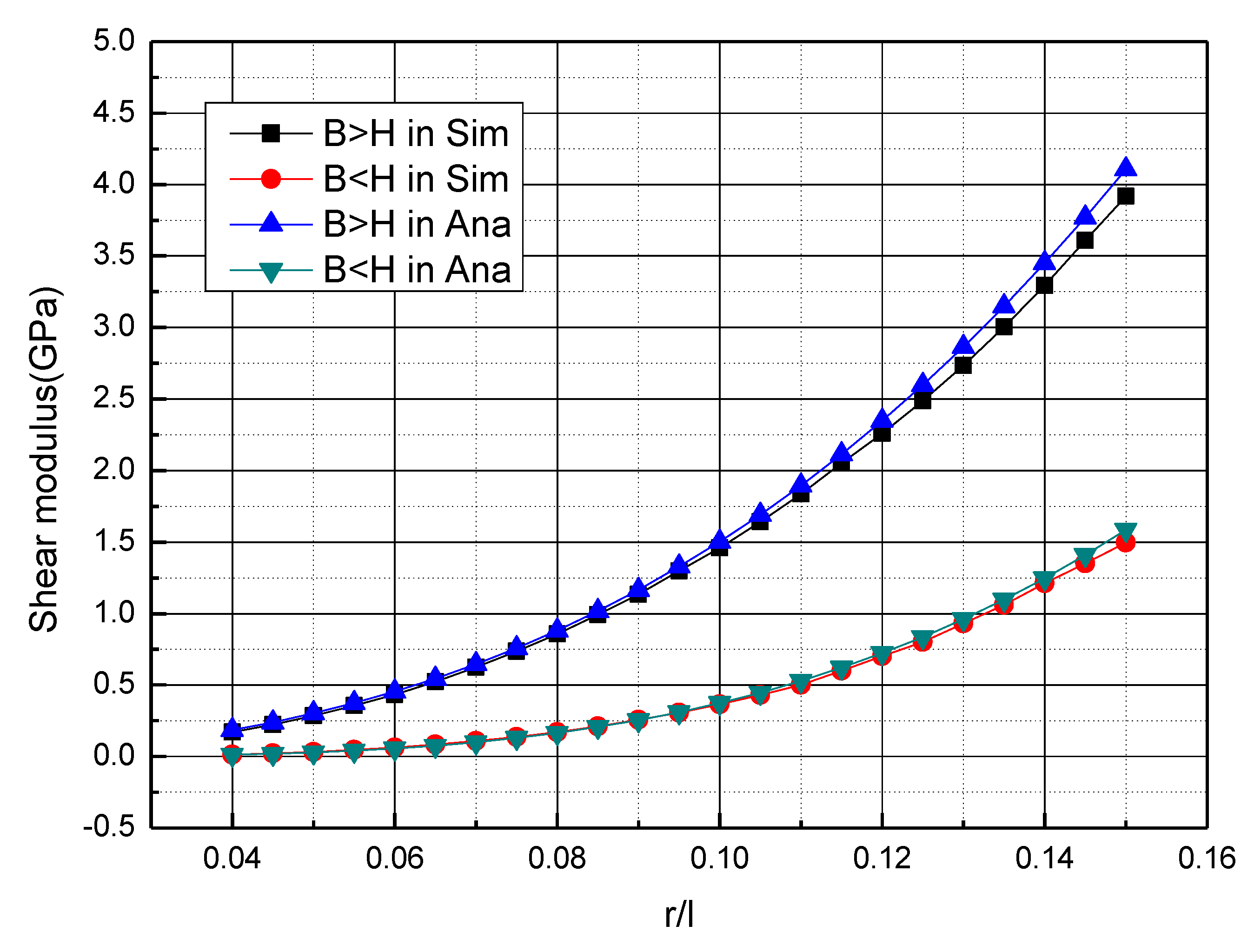
| Element | C | Cr | Ni | Si | Mn |
| Values | ≤0.08 | 18~20 | 8~11 | ≤1 | ≤2 |
| Element | P | S | N | O | Fe |
| Values | ≤0.045 | ≤0.03 | ≤0.25 | ≤0.1 | other |
| Layer thickness | 0.05 mm |
| Phase angle | 67° |
| Laser power | 250 w |
| Scan interval | 0.11 mm |
| Scan speed | 800 mm/s |
| Metallic powder | 304 stainless steel |
| No | Cell Number | r/l | Simulation of Shear Modulus/GPa | Analysis of G1/GPa | Analysis of G2/GPa | Analysis of Shear Modulus/GPa | Error |
|---|---|---|---|---|---|---|---|
| 1 | 7 × 7 × 7 | 0.13 | 1.61 | 6.46 | 0.59 | 1.55 | 3.83% |
| 2 | 10 × 10 × 10 | 0.13 | 1.66 | 6.31% | |||
| 3 | 13 × 13 × 13 | 0.13 | 1.68 | 7.55% | |||
| 4 | 7 × 7 × 7 | 0.14 | 1.98 | 7.55 | 0.79 | 1.99 | 0.48% |
| 5 | 10 × 10 × 10 | 0.14 | 2.03 | 1.91% | |||
| 6 | 13 × 13 × 13 | 0.14 | 2.05 | 2.71% | |||
| 7 | 7 × 7 × 7 | 0.15 | 2.40 | 8.73 | 1.04 | 2.52 | 4.67% |
| 8 | 10 × 10 × 10 | 0.15 | 2.45 | 2.65% | |||
| 9 | 13 × 13 × 13 | 0.15 | 2.48 | 1.65% |
| No | Structure Diameters D/mm | Structure Length L/mm | r/l | /Mpa | /Mpa | Error (Ana and Exp) | |||
|---|---|---|---|---|---|---|---|---|---|
| Min. | Max. | Aver. | |||||||
| 1 | 1.17 | 1.23 | 1.2 | 3.464 | 0.173 | 3.65 | 3.50 | 3.58 | 1.89% |
| 2 | 0.95 | 1.05 | 1.00 | 3.464 | 0.144 | 2.26 | 2.12 | 2.19 | 3.10% |
| 3 | 0.93 | 1.04 | 0.985 | 3.464 | 0.142 | 2.19 | 2.04 | 2.09 | 4.6% |
| 4 | 1.19 | 1.26 | 1.225 | 3.464 | 0.177 | 3.79 | 3.72 | 3.85 | 1.58% |
Publisher’s Note: MDPI stays neutral with regard to jurisdictional claims in published maps and institutional affiliations. |
© 2022 by the authors. Licensee MDPI, Basel, Switzerland. This article is an open access article distributed under the terms and conditions of the Creative Commons Attribution (CC BY) license (https://creativecommons.org/licenses/by/4.0/).
Share and Cite
Zhang, W.; Zhao, J.; Tan, Y.; Gao, Y.; Wang, J.; Geng, X. Study on the Shear Modulus Based Equivalent Homogenization Methods of Multi-Layer BCC Lattice Sandwich. Materials 2022, 15, 1341. https://doi.org/10.3390/ma15041341
Zhang W, Zhao J, Tan Y, Gao Y, Wang J, Geng X. Study on the Shear Modulus Based Equivalent Homogenization Methods of Multi-Layer BCC Lattice Sandwich. Materials. 2022; 15(4):1341. https://doi.org/10.3390/ma15041341
Chicago/Turabian StyleZhang, Wukun, Jian Zhao, Yonghua Tan, Yushan Gao, Jun Wang, and Xiaoliang Geng. 2022. "Study on the Shear Modulus Based Equivalent Homogenization Methods of Multi-Layer BCC Lattice Sandwich" Materials 15, no. 4: 1341. https://doi.org/10.3390/ma15041341
APA StyleZhang, W., Zhao, J., Tan, Y., Gao, Y., Wang, J., & Geng, X. (2022). Study on the Shear Modulus Based Equivalent Homogenization Methods of Multi-Layer BCC Lattice Sandwich. Materials, 15(4), 1341. https://doi.org/10.3390/ma15041341






